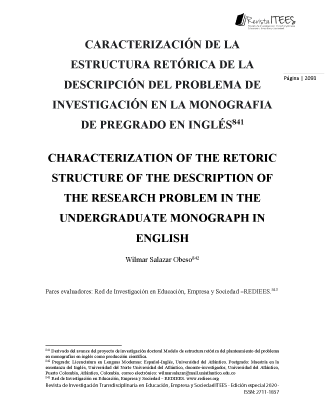CIX. CARACTERIZACIÓN DE LA ESTRUCTURA RETÓRICA DE LA DESCRIPCIÓN DEL PROBLEMA DE INVESTIGACIÓN EN LA MONOGRAFIA DE PREGRADO EN INGLÉS8
##plugins.themes.bootstrap3.article.main##
Resumo
A descrição do problema de pesquisa precisa de uma estrutura retórica que dê conta de sua finalidade comunicativa.
sua finalidade comunicativa. Esta estrutura dá uma hierarquia lingüística às idéias
que levam à existência do problema da pesquisa. No entanto, há uma ausência de
estudos lingüísticos desta seção a nível de graduação em monografias em inglês. O
A principal intenção da presente pesquisa é caracterizar a estrutura retórica da descrição do problema.
estrutura retórica da descrição do problema de pesquisa na monografia da graduação em inglês.
Inglês. O estudo empregou uma análise de gênero, seguindo o modelo CARS: Criar um Espaço de Pesquisa.
Espaço de Pesquisa (CARS) modelo de Swales (1990). Analisamos 20
descrições de problemas de pesquisa de monografias escritas por professores de graduação em línguas estrangeiras
Os resultados mostraram: 1. um propósito de pesquisa do problema de pesquisa, e 2. um propósito de pesquisa do problema de pesquisa.
Os resultados mostraram: 1. um propósito comunicativo indefinido e uma estrutura retórica da descrição do problema de pesquisa.
2. falta de consciência lingüística na realização da estrutura retórica da monografia de pesquisa.
2. falta de consciência lingüística na realização da estrutura retórica em questão. Concluiu-se que uma retórica
A estrutura retórica é necessária para comunicar melhor o propósito comunicativo da descrição do problema.
problema.
Download Statistics
##plugins.themes.bootstrap3.article.details##
gênero, análise de gênero, modelo CARS, problema de pesquisa, monografia, análise de gênero, modelo CARS
Bhatia, V. (1996). Methodological issues in genre analysis. Hermes. Journal of linguistics,
16(39-59).
Bhatia, V. (1993). Analysing Genre: Language Use in Professional Settings. London:
Longman. Disponible en:
https://www.scirp.org/(S(oyulxb452alnt1aej1nfow45))/reference/ReferencesPapers.
aspx?ReferenceID=1729630
Brett, P. (2004). A genre-analysis of the results section of sociology articles. English for
Specific Purposes. 13, 1-59. Disponible en: https://eric.ed.gov/?id=EJ481597
Biber, D. Connor, U. and Upton, T. (2007). Discourse on the move. Using corpus analysis
to describe discourse structures. Philadelphia: John Benjamins Publishing Company.
Buendia, L., Colás, B., and Hernández, F. (1998). Métodos de investigación en
psicopedagogía. Madrid: McGraw-Hill.
Cárdenas, L. (2016). La lectura y la escritura en la educación superior. Alfabetización
académica en la Región Caribe colombiana. Puerto Colombia: Sello Editorial
Universidad del Atlántico.
Christie, F., & Martin, J. R. (Eds.). (1997). Genre in institutions: Social processes in the
workplace and school. New York: Continuum.
Creswell, J. (2014). Research design: qualitative, quantitative, and mixed methods. 4th
edition. Los Angeles: SAGE.
Devitt, A. J. (2004). Writing genres. Carbondale: Southern Illinois University Press.
Gomez et al. (2014). Cómo hacer tesis de maestría y doctorados: Investigación, escritura y
publicaciones. Bogotá: Eco Ediciones.
Goldkuhl, G. (2011). Pragmatism vs interpretivism in qualitative information systems
research. European Journal of Information Systems, (21), 2, 135-146. Disponible en:
http://urn.kb.se/resolve?urn=urn:nbn:se:liu:diva-76528
Hernon & Metoyer-Duran, C. (1993). What is a problem statement? Library & Information
Science Research, 29, 307-307.
Metoyer-Duran, C., & Hernon, P. (1994). Problem statements: An exploratory study of their
function, significance, and form. Library & Information Science Research, 15, 71-92.
Hopkins, A & Dudley-Evans, T. (1988). A genre-based investigation of the discussion
sections in articles and dissertations. English for Specific Purposes, 7(113-22).
Hyland, K. (2003). Second Language Writing. New York. Cambridge University Press.
Hyland, K. (2008). Genre and academic writing in the disciplines. Language Teaching,
41(04), pp 543-562.
Jalilifar, A., Firuzmand, S., & Roshani, S. (2011). Genre analysis of problem statement
sections of MA proposals and theses in Applied Linguistics. Language, Society and
Culture, (33), 85–93. Disponible en: http://scholar.google.com/scholar
Johns, A. M. (2008). Genre awareness for the novice academic student: an ongoing quest.
Language Teaching, 41(2): 237-252.
Mahjoobeh, Sh. (2015). Analysis of verb tenses and voice of research articles abstracts in
Engineering journals. International letters of social and humanistic sciences,47, P.
139-152. Disponible en: https://www.gesis.org/ssoar/home
Martin, P., and León, I. (2009). Promotional strategies inresearch articles introductions: an
interlinguistic and cross-cultural genre analysis. Revista Canaria de Estudios en
Ingles, 50. 73-83.
Millar, D. (2011). Promoting genre awareness in the EFL students. English teaching forum.
No. 2. Disponible en:
https://americanenglish.state.gov/files/ae/resource_files/promoting_genre_awarenes
s_in_the_efl_classroom.pdf
Monje, A. C. (2011). Cómo presentar la monografía de grado o el informe de investigación.
Universidad Surcolombiana.
Nimehchisalem, V., Tarvirdizadeh, Z., Paidary, S.S., & Hussin, N.I. (2016). Rhetorical
Moves in Problem Statement Section of Iranian EFL Postgraduate Students’ Theses.
Disponible en: http://www.journals.aiac.org.au/index.php/alls/article/view/2507
Parsa, s., and Hasam, M. (2017). Move Structures in “Statement-of-the-Problem” Sections
of M.A. Theses: The Case of Native and Nonnative Speakers of English. Iranian
Journal of Applied Linguistics (IJAL), 20(2), September, 195-228. Disponible en:
https://ijal.khu.ac.ir/files/site1/user_files_795657/parsa-A-10-818-2-a74c4c0.pdf
Oliveira, F. (2017). A organização retórica da seção de considerações finais do gênero
monografia em comunidades disciplinares distintas. Disponible en:
http://hdl.handle.net/123456789/544
Rozimela, Y. (2014). The students’ genre awareness and their reading comprehension of
different text types. International Journal of Asian and Social Science, 4, 460-469.
Disponible en: https://www.semanticscholar.org/paper/THE-STUDENTS%27-
GENRE-AWARENESS-AND-THEIR-READING-OFRozimela/77d921fd460addb0ed40f9061eb3aadb4419dece
Salayer-Meyer, F. (1990). Discoursal flaws in medical English abstracts: a genre analysis
per research and text type. 10, 365-384. New York: Walter de Gruyter, Berlin.
Samraj, B. (2002). Introductions in research articles: variation across disciplines. English
for Specific Purpose. 21: 1-17.
Swales, J. (1981). Aspects of article introductions. Birmingham. England: Universidad de
Aston.
Swales, J. (1990). Genre Analysis - English in Academic and Research Settings. Cambridge:
Cambridge University Press.
Zayas, F. (2012). Los géneros discursivos y la enseñanza de la composición escrita. Revista
Iberoamericana de Educación. N.º 59, pp. 63-85. Disponible en:
https://rieoei.org/historico/documentos/rie59a03.pdf





